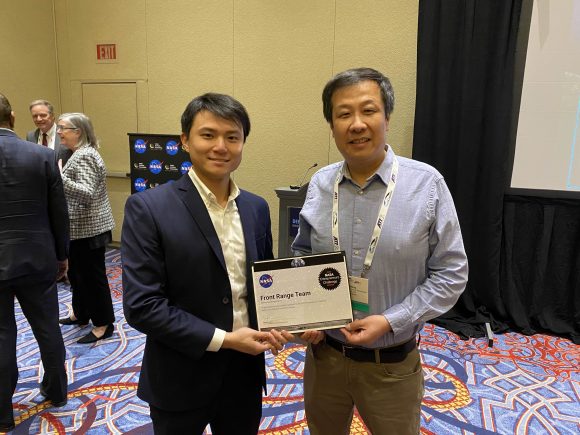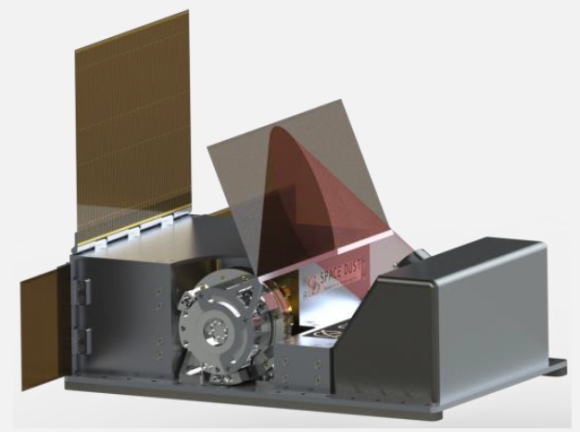
Research scientists Kenneth Liang (left) and Xu Wang (right) after winning the 2023 NASA Entrepreneurs Challenge. (Courtesy of Xu Wang)
Researchers at the University of Colorado Boulder are working to make the moon habitable. And they are focused on one of the most difficult challenges to lunar living: dust.
Xu Wang, a research scientist at the Laboratory for Atmospheric and Space Physics at CU Boulder, was one of the winners of NASA’s 2023 Entrepreneurs Challenge.
Along with researchers at the Colorado School of Mines, CU’s LASP created a concept for a type of “cosmic gas station” with charging ports and an electron beam to blast lunar dust.
“The idea is to build something like a service station– or we call ‘gas station’– on the moon,” Wang said. “You stop by a station and you can recharge your rovers and also you can clean your rovers– like a car wash. So you ‘pump your gas’ and you go ‘wash your car.’”

Conceptual model of the Lunar Anti-Dust Microgrid lunar lander payload, including an electron beam dust mitigation solution. (Courtesy of Xu Wang)
During NASA’s Apollo missions in the late 20th century, astronauts encountered the sticky nature of lunar dust, a pervasive kind of material that stuck to spacesuits and rockets– virtually anything that neared the moon’s surface.
“It more or less coats and covers every surface on the moon which means that no matter where you go on the moon you’re going to encounter it and you’re going to have to deal with it in various ways,” said Paul Hayne, a planetary scientist at CU Boulder.
Lunar dust is highly charged so it is attracted to anything that lands nearby.
“The charged effect makes it easier to stick on surfaces. So it’s very hard to get rid of,” Wang said.
Additionally these dust particles are sharp. Without wind or water, the moon lacks the same erosion processes that grind down earth’s dust.
The moon’s dusty layer is instead the result of meteoroids and charged celestial particles hitting the moon’s surface. Wang said these particles pose a safety risk to space explorers, describing them as akin to “broken glass.”
“[Lunar dust particles] are really abrasive, very sharp. They can cut through the spacesuit fabric so that would be dangerous for astronauts,” Wang said.
Hayne agreed. He also expressed concern for the health risks of inhaling these particles.
“Trying to keep the dust off of things is a challenge. And one of the reasons we want to keep dust off of things is that the highly reactive, shards-of-glass nature of the lunar dust means that it can be toxic,” he said.
The LASP team’s idea for their service station involves an electron beam that blasts away the static-y sharp lunar dust particles. Wang and his colleagues are continuing to solve this dust issue at a crucial time for lunar exploration.
NASA is in the midst of its newest set of lunar missions called “Artemis.” Future Artemis missions aim to bring insight into living on another planet and inspire future settlements on Mars. The next lunar mission in the Artemis itinerary is set tentatively for 2025.
“Everybody’s talking about ‘we’re going back to the moon’ but the huge difference from the Apollo missions is that this time we will stay and not for a week, not for months, not for a year, probably for decades,” Wang said. LASP’s service station is meant to aid long term missions to the moon and potentially further, like a rest stop in between a road trip from Boulder to California, described Wang.
While he believes himself to be too old to make it to the moon himself, Wang is incredibly passionate about aiding future missions. For him, cosmic dust is not just a career, it’s a passion.
“If you go back even further to how stars form. Stars form by gas and dust. That’s it,” he said. “So everything’s made of dust.”
Contact CU Independent News Editor Ann Marie Vanderveen at ann.vanderveen@colorado.edu.
